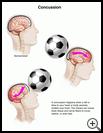
Head Injury
What is a head injury?
There are 3 main types of head injuries:
Scalp injury: Most head injuries are a scalp injury. It is common for children to fall and hit their head at some point while growing up. This is especially common when a child is learning to walk. Falls often cause a bruise on the forehead. Sometimes black eyes appear 1 to 3 days later because the bruising spreads downward by gravity. Big lumps can occur with minor injuries because there is a large blood supply to the scalp. For the same reason small cuts on the head may bleed a lot.
Skull fracture: Head injuries that you can't see on the outside of the head are a skull fracture or a concussion. Only 1% to 2% of children with head injuries will get a skull fracture. Usually there are no other symptoms except for a headache at the site where the head was hit.
Concussion: A concussion is a mild injury to the brain that changes how the brain normally works. It is usually caused by a sudden blow or jolt to the head. Many children bump or hit their heads without causing a concussion. Signs of a concussion can include headache, nausea, vomiting, dizziness, confusion, forgetting what happened around the time of the injury, acting dazed, or being knocked out. A person does NOT need to be knocked out or lose consciousness to have had a concussion.
If your child has a concussion, there may be some ongoing symptoms such as mild headaches, dizziness, thinking difficulties, or behavioral/emotional changes for several days to weeks. All children with a concussion will need to have follow-up with their healthcare provider.
How can I take care of my child?
- Wound care
If the skin is split open and might need stitches, call your healthcare provider right away. If there is a scrape, wash it off with soap and water. Then apply pressure with a clean cloth (sterile gauze if you have it) for 10 minutes to stop any bleeding. For any small cuts, apply antibiotic ointment (OTC) twice a day until healed. For swelling, apply a cold pack or ice bag for 20 minutes. This will also reduce pain.
- Rest
Encourage your child to lie down and rest until all symptoms have cleared (or at least 2 hours). Your child can be allowed to sleep. You do not need to try to keep your child awake continuously. Just have him sleep nearby so you can periodically check on him.
- Diet
Only give clear fluids (ones you can see through) until your child has gone 2 hours without vomiting. (Vomiting once is common after head injuries.)
- Pain medicines
Give acetaminophen (Tylenol) or ibuprofen (Advil), as needed for pain relief. Caution: wait 2 hours to be sure your child isn’t going to vomit from the head injury.
- Special precautions and awakening
- Although your child is probably fine, watch him or her closely for 24 hours after the injury. Sleep in the same room with him for the first night after the injury. That way, if he develops any symptoms, you will be nearby. Awakening him to check the ability to walk and talk is optional, unless his breathing or sleep pattern becomes abnormal. If your child does fine for 24 hours, return to a normal routine.
It is not necessary to check your child's pupils to make sure they are equal in size and become smaller when you shine a flashlight on them. Unequal pupils are never seen before other symptoms such as confusion and trouble walking. In addition, this test is difficult to perform with uncooperative children or dark-colored irises.
- Returning to sports
Children with a concussion should not return to sports activities or gym until your healthcare provider says it is safe to do so and your child no longer has any symptoms. If your child returns too soon and has another blow to the head he or she can develop another concussion and have an increased risk of further brain injury.
When should I call my child's healthcare provider?
The doctor who saw your child has determined that your child can be sent home to be further observed.
Call IMMEDIATELY if:
- The skin is split open and might need stitches.
- The headache becomes severe.
- Vomiting occurs 2 or more times.
- Your child's vision becomes blurred or double.
- Your child becomes difficult to awaken or confused.
- Walking or talking becomes difficult.
- Your child develops any new symptoms.
Last modified: 2017-06-05
Last reviewed: 2017-06-05

